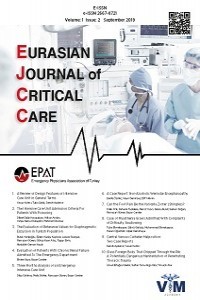Pre Hospital Cutting-Punching Tool Injuries At Emergency Health Services: Konya Sample
Pre Hospital Cutting-Punching Tool Injuries At Emergency Health Services: Konya Sample
Sharp objects Injuring, Emergency Health Services,
___
- 1. Tabak RS., İ. Somyürek. Temel İlk Yardım ve Acil Bakım, 2. Baskı. Palme Yayıncılık: Ankara; 2008.
- 2. İl Ambulans Servisi Çalışma Yönergesi, 24.01.2005
- 3. Tokuç B, Y. Turunç, G. Ekuklu. Edirne’de ambulans çalışanlarının anksiyete, depresyon ve işe bağlı gerginlik düzeyleri, Mesleki Sağlık ve Güvenlik Dergisi. 2011; 42: 39-44.
- 4. TTB Sağlık çalışanlarının mesleki riskleri, TTB Yayınları; Ankara; 2008.
- 5. https://www.who.int/violence_injury_prevention/violence/workplace/en/ (Access 21.02.2020)
- 6. Arsal Yıldırım S., S. Gerdan. Hastane öncesi acil sağlık çalışanlarının iş sağlığı ve güvenliği kapsamındaki mesleki riskleri, Hastane Öncesi Dergisi. 2017; 2(1): 37-49.
- 7. Kahya E., S. Sakarya, H. Özkan, N. Anık. Work related injuries and exposures among emergency medical service personnel due to interior design of ambulance, Estüdam Halk Sağlığı Dergisi. 2020; 5 (2) : 257-269.
- 8. Gülen B., M. Serinken, C. Hatipoğlu, D. Özaşır, E. Sönmez, G. Kaya, G. Akpınar. Work-Related injuries sustained by emergency medical technicians and paramedics in Turkey, Ulusal Travma Aci lCerrahi Dergisi. 2016; 22(2): 145-149.
- 9. Akkaya S., G. Şengöz, F. Pehlivanoğlu, EG. Özdemir, ŞA. Tek. Kesici ve delici alet yaralanmalarıyla ilgili anket sonuçlarının değerlendirilmesi, Klimik Dergisi. 2014; 27: 95-8
- 10. Uysal Ü., H. Ellidokuz, E. Ucan. Dokuz Eylül Üniversitesi Uygulama ve Araştırma Hastanesi çalışanlarında kesici delici cisim yaralanma sıklığı, Kocatepe Tıp Dergisi. 2002; 3 43-49.
- 11. Merih YD., MY. Kocabey, F. Çırpı, Z. Bolca, AC. Celayir. Bir devlet hastanesinde 3 yıl içerisinde görülen kesici-delici aletyaralanmalarının epidemiyolojisi ve korunmaya yönelik önlemler, Zeynep Kamil Tıp Bülteni. 2009; 40 (1): 11-15.
- 12. Goel V., D. Kumar, R. Lingaiah, S. Singh. Occurrence of needlestick and injuries among health-care workers of a tertiary care teaching hospital in North India, Journal of Laboratory Physicians. 2017; 9(1): 20-25.
- 13. Isara A., K. Oguzie, O. Okpogoro. Prevalence of needlestick injuries among healthcare workers in the accident and emergency department of a teaching hospital in Nigeria, Annals of Medical and Health Sciences Research. 2015; 5(6): 392- 396.
- 14. Amini M., MJ. Behzadnia, F. Saboori, M. Bahadori, R. Ravangard. Needle-stick injuries among healthcare workers in a teaching hospital, Trauma Monthly. 2015; 20(4): e18829.
- Başlangıç: 2019
- Yayıncı: Acil Tıp Uzmanları Derneği
Posterior Reversible Encephalopathy Case In Emergency Department
Dilber ÜÇÖZ KOCAŞABAN, Sertaç GÜLER
Pre Hospital Cutting-Punching Tool Injuries At Emergency Health Services: Konya Sample
Hasan KÜÇÜKKENDİRCİ, Serap BATI
Serhat ÖRÜN, Efe Mehmet Can KIRCA
Chronic Kidney Disease and Health Literacy
Hatice Şeyma AKÇA, Serdar ÖZDEMİR
Covid-19 Pandemic, Restrictions and Rhabdomyolysis
Bedia GULEN, Bahadir TASLİDERE, Yasin UGUR, Ayse Busra OZCAN, Ertan SONMEZ
Management of a Case of Gangrenous Cholecystitis Detected in the Emergency Department
Paraoxonase Activity In Patients With Chronic Obstructive Pulmonary Disease
Kerim YEŞİLDAĞ, Turgut TEKE, Sami ERDEM
Effect of Using Metoclopramide and Ondansetron in the Emergency Department on the Treatment Duration
Oya GÜVEN, Özlem TATAROĞLU, Dilay SATILMIŞ, Mehmet ERDOĞAN
